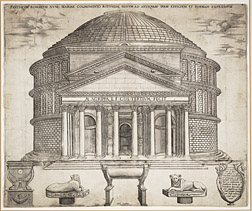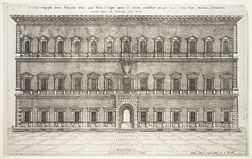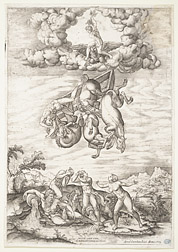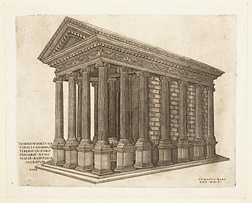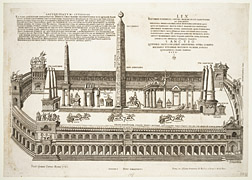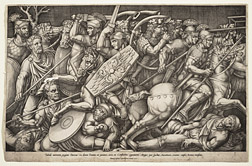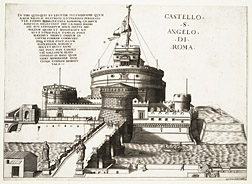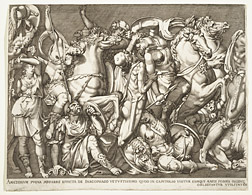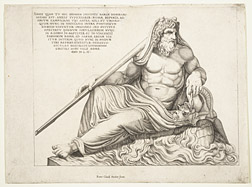Beatrizet and the Speculum
The Pantheon 1549
Today known only as a major monument of ancient Rome, in 609 the structure was consecrated as a church, dedicated to Mary and all the Christian martyrs. At this time Salamanca and Lafreri were in business separately, and Beatrizet engraved images of the Pantheon for both. First Lafreri hired Beatrizet to make a quite straightforward view of the structure. This presumably was popular, because soon afterward Salamanca engaged him to make an engraving of the same monument, which included the two lions and the sarcophagus that are still visible in front of the building. Lafreri, not to be outdone, reissued his print in the form you see here, with a small plate added at the bottom, providing still more information―a view of one of the lions from the back, the sarcophagus from its end, and an antique vase not shown in the Salamanca print at all. Beatrizet's monogram was at the lower left in the original but was obscured when the new plate was added.
The Farnese Palace 1549
Buyers of souvenir prints from Rome were interested not only in ancient monuments, but also in the luxurious new palaces built for the ruling families in the "modern," i.e. classical, style. The Farnese palace was commissioned from Antonio da Sangallo by Cardinal Alessandro Farnese around 1515, but was still unfinished at Sangallo's death in 1546. By this time Alessandro Farnese had been elected as Pope Paul III, and he commissioned Michelangelo to finish the work. About 1546 Michelangelo designed the huge cornice that imparts a majestic grandeur to the building and also the balconied opening in the second story, crowned by the papal coat of arms. Just as for the images of the Pantheon, Beatrizet was hired by the two rival publishers: in this instance the undated plate for Salamanca, in which the shadows fall to the right, was probably first; this one, with shadows to the left, is dated 1549.
Fall of Phaeton c. 1550?
Michelangelo was the undisputed star of contemporary art in the middle of the sixteenth century in Rome, and Beatrizet engraved six of his drawings or paintings, plus the statue of the Risen Christ (an engraving of this statue, by Jan de Bisschop, is no. C976 in the Chicago Speculum). This Fall of Phaeton, reproducing a drawing made for Tommaso Cavalieri about 1533, may not have been originally done by Beatrizet, since it is inscribed: N BEATRIZET LOTAR RESTITUIT, "N Beatrizet of Lorraine restored it," but the original engraver is unknown. Also unknown is the route by which Michelangelo's compositions reached the publisher and/or engraver―no document attests to Michelangelo having had any particular relationship with a publisher, and Michelangelo, in fact, is known to have made disdainful remarks about prints. The image apparently continued to be in demand for more than two hundred years, as is made evident by the date of 1773 put on the plate by the publisher Carlo Losi.
Temple of Fortuna Virilis 1550
This exquisite little temple was also used as a church in the medieval and Renaissance eras, dedicated to Saint Mary of Egypt, as the inscription indicates. It was published, in 1550, by yet another of the men Beatrizet worked for, Tommaso Barlacchi, for whom Beatrizet had made three plates back in 1541, of figural subjects by Raphael. The plates Beatrizet made for Barlacchi were smaller than those he did for other publishers, perhaps indicating that Barlacchi had a smaller press. The Jubilee year at mid century would have brought thousands of pilgrims―potential customers for prints―to Rome, although this is Beatrizet's only plate actually bearing that date. Beatrizet's monogram, "N. B. F." ("F" for fecit, "made") is at the bottom of the plinth supporting the leftmost column. Engraved in very regular slanting strokes, the plate shows Beatrizet in complete command of his technique.
Circus Maximus 1553
By the 1550s scholarly antiquarianism had a vogue of immense proportions in Rome. The Neapolitan Pirro Ligorio, artist and architect, was also the leading antiquarian and archaeologist of the mid-sixteenth century, and Beatrizet's engraving is based on Ligorio's reconstruction of a model―in wax according to the lengthy inscription on the print―of the Circus Maximus, following ancient authors. The detail and accuracy of the reconstruction are impressive: it shows the long central barrier (spina) flanked by arches supporting three cones, the barrier itself with its large and smaller Egyptian obelisks with hieroglyphs, temples to the sun, the moon, and Neptune, smaller statues, and triumphal arches. The Circus was used primarily for chariot racing, and three quadrigas are seen on the near side of the course. Michele Tramezzini was a publisher established in Venice, but his brother Francesco was in Rome, and the print proclaims that it was sanctioned by Pope Julius III. This plate is among the largest generally made at this era; the dimensions may well reflect the upper limits in the size of presses of the time.
Relief on the Arch of Constantine 1553
The same growing antiquarian interest that led to Tramezzini's publication of the plates of the Circus Flaminius and Circus Maximus inspired Lafreri to commission images of ancient bas reliefs, like this section of a Trajanic frieze showing the emperor's victorious combat over the Dacians, which had been incorporated into the Arch of Constantine. Dated 1553, this plate manifests a suppleness in the handling of the burin that increased in Beatrizet's work over the course of the 1550s. Another plate in the Chicago Speculum (A98) of one of these Trajanic reliefs in the Arch of Constantine has been thought to constitute a pair with this engraving and also to have been made by Beatrizet, but that one has no signature or monogram, it is slightly smaller, and the subject is reversed whereas Beatrizet's print represents the relief in its true direction.
Castel Sant'Angelo, first state
The building known as the Castel Sant'Angelo was originally built by the emperor Hadrian as a mausoleum for himself and his family. Later it was used by the popes as a castle and fortress. The second state of Beatrizet's print (A46) has been thought to be a copy of the first (A26), but close examination reveals that the two prints were pulled from the same plate. The confusion is understandable, because the plate underwent extensive reworking in its second state, some thirty years after the first. The engraving was originally made during the pontificate of Pius IV, between 1559 and 1565, as is shown by the Medici coat of arms above the arched doorway leading from the rampart at the left, and on the banner flying above. Later the Sfondrati coat of arms of Pope Gregory XIV (r. 1590-91) was substituted in those two places. Those changes, however, were just the beginning. The fortification to the right of the print underwent a notable change of shape―although the original outlines can still be discerned, further evidence that the prints are from the same plate―and a great deal of crosshatching was added, increasing the contrast of the image but also stiffening Beatrizet's more fluid lines. Sections of the plate that were not touched, however, as for instance the lettering, can clearly be seen to be identical in the two prints.
Castel Sant'Angelo, second state
(Compare this print of the Castel Sant'Angelo with the previous print, A26.)
Battle of the Amazons 1559
Beatrizet's second-largest work is this image, on two plates, of a sarcophagus showing the Battle of the Amazons. (His largest work is his engraving on ten plates of Michelangelo's Last Judgment, which he made in 1562, copying the engraving made in the late 1540s by Giorgio Ghisi.) In 1558 Beatrizet had issued an engraving of the siege by the French of Thionville, in his native Lorraine; that was his first dated print indicating that he was not only the engraver of the plate, but also its publisher. From that time onward, Beatrizet did no more work for other publishers. In the bottom margin of this masterful engraving is the proud inscription: "Nicolas Beatrizet from Lorraine engraved this Battle of the Amazons from an antique sarcophagus visible on the Capitoline, and published it at his own expense for the good of all those who take pleasure in antique things". It is precisely dated to the Kalends of January 1559.
Ocean 1560
The last of Beatrizet's engravings on this itinerary depicts a statue of a reclining Oceanus, excavated in 1556. Beatrizet rendered the statue reversed from its true direction. According to the inscription it was found near the place where the statues of the river gods Nile and Tiber had been dug up many years previously. Also according to the inscription, at the date Beatrizet made this engraving, 1560, the statue was in the possession of Giovanni Battista and Giovanni Vincenzo Fabio; it was later acquired by Cardinal Alessandro Farnese (grandson of Pope Paul III, who had built the Farnese Palace, see A63 above) and eventually went with the Farnese collection to Naples. Because of the similarity of this subject to the river gods Nile and Tiber, and perhaps because those statues are mentioned in the inscription here, the anonymous engravings of those sculptures (A108, A109) have been attributed to Beatrizet, but those prints―delightful as they are with their depictions of a sphinx and putti climbing on the Nile, Romulus and Remus and the wolf with the Tiber, and the reliefs on their bases shown around three sides―are engraved with a harder technique than Beatrizet's relaxed and supple line. There still remains ample work for scholars to sort out the hands of the many anonymous engravers of prints that found their way into Speculum collections.


